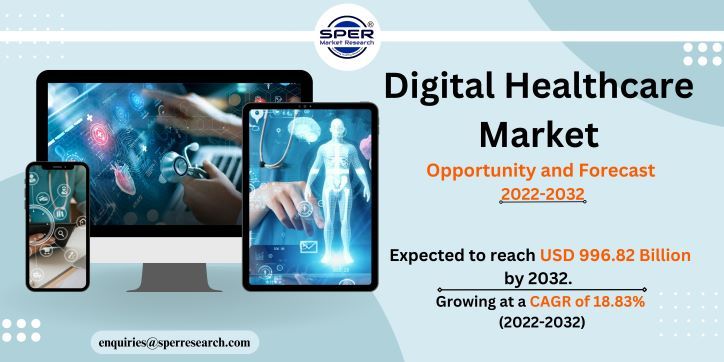
Digital Healthcare Market Share Report 2032: Sper Market Research
A few things that are assisting the digital healthcare industry are the increasing usage of big data in healthcare, the increasing usage of EMR and HER systems, the help carried out to keep patients’ electronic health records up to date, and regulatory demands. The market is also increasing faster owing to more money being put into mHealth companies and preventive care is becoming more prevalent. Growing penetration of smartphones, innovation in healthcare IT infrastructure, advanced internet connectivity with the introduction of 4G or 5G, the growing requirement to curb healthcare costs, and the growth in accessibility of virtual care are some of the foremost aspects to propel the market growth.
In addition, key market players aim on introducing improved applications to advance user experience. For instance, during July 2021, Teladoc Health partnership with Microsoft to integrate its Solo platform with the Microsoft Teams environment to advance clinician and patient admittance around the virtual healthcare space.

According to the SPER market research, ‘Digital Healthcare Market Size- By Technology, By Component, By End User, By Application- Regional Outlook, Competitive Strategies and Segment Forecasts to 2032’ state that the Digital Healthcare Market is predicted to reach USD 996.82 billion by 2032 with a CAGR of 18.83%.
An increase in the prevalence of chronic diseases, and aging populations are the requirement for medical experts in different regions. Telemedicine or telemedicine services assist doctors to arrive at more patients. This will advance admittance to healthcare, advance the usage of the patient, and physician time, and help decrease healthcare expenditure. Individuals living in remote locations have to travel hours to get treatment, but now the masses can encounter their medical requirements through telemedicine, assisting the growth of the market.
The pandemic has introduced several challenges for international healthcare services. However, this situation has delivered a much-required boost to digital health technologies in the area of disease surveillance, fresh strategy advancement, and frontline care services. Several regions have implemented telehealth, remote monitoring platforms, and telemedicine services to allow physical interactions between patients and physicians population. Hence, the industry is predicted to experience a foster in terms of market revenue during the review period and would follow an upward predicted technology life cycle trajectory till the reviewed duration.
Request For Free Sample Report @ https://www.sperresearch.com/report-store/digital-healthcare-market.aspx?sample=1
The annual growth is caused by aspects such as innovation in internet connectivity, a speedily growing shortage of healthcare experts, speedily increasing smartphone utilization, growing medical costs, widespread adaptability of telehealth application locations, and speedily growing physicians and patient acceptance of these technologies. Speedily technical innovations and unremitting telehealth application evolution propel the segment’s enlargement.
North America is one of the very first regions to adopt smart healthcare solutions, involving different technologies likewise smart wearables, mobile apps, and eHealth services, such as HER and telemedicine services, for remote admittance to information on severe, and chronic healthcare situations. Aspects such as speedy growth in the implementation of smartphones, developments in coverage networks, augment in the prevalence of chronic syndromes, augment in geriatric populace, and the increase in costs of healthcare are accountable for the growth of the market.
For More Information, refer to below link:-
Digital Healthcare Market Future Outlook
Related Reports:
Follow Us –
LinkedIn | Instagram | Facebook | Twitter
Contact Us:
Sara Lopes, Business Consultant – U.S.A.
SPER Market Research
+1-347-460-2899
Appreciate the creator